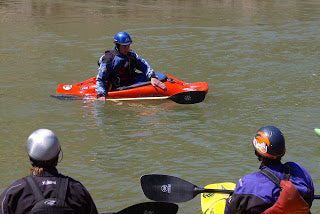1. Always, always get your friend paddling around in a lake or pool to start. Don't start on a river, unless you have a nice BIG pool to use that is basically like paddling in a lake. The first thing they should do is flip over and wet exit. Everyone has a fear of being trapped upside down in the boat before they actually try it, and realize it's no big deal.

2. Teaching someone to roll is not the same as teaching them to kayak. This is one of the most common mistakes I see. A beginner learns to roll, then hits the river and they don't even know how to paddle a kayak. Also, most beginners who learn a pool roll can't combat roll yet anyway. So when they are on the river, it's as if they've never even been in a kayak. their roll is useless and they have no other skills to get them down the river. I teach the roll AFTER I've taught them the other basic strokes, braces, t-rescues, etc. Once they've done all that, they are more comfortable in the boat, and rolling is much easier to learn.

3. We all know how hard it is to get a whitewater kayak to go straight when you are a beginner. Let's face it, these things are designed to turn easily. So I always start by teaching them to balance the boat and sit with the proper posture. Then I start teaching turning and corrective strokes like sweeps and stern draws. Then when you get to the forward stroke, they already know how to correct their direction when they veer off course. I also don't emphasize perfecting the forward stroke as a beginner. I think it develops over time. Think about it. In a whitewater rapid, how far do you generally need to paddle in a straight line? maybe 10-15 feet or less at a time. Whitewater paddling is basically connecting short bursts of forward strokes and turns to link all the moves you need. Rarely does a whitewater kayaker need to paddle in straight line for a long distance in a rapid. Mastering turning and correcting strokes as well as balance and bracing is more important for a beginner than having a beautiful forward stroke. Not that a good forward stroke isn't important, it's just something that they need to work on over their first couple of seasons.
4. Teach the sweep roll. It's easier to learn and more reliable in aerated water.
5. Once your friend is ready to hit the river, choose the river wisely. Class 2 rivers with lot's of eddies are best. Class 2 rivers that are lined with strainers and bushes are not very good. Class 3 rivers are never suitable for the first time on the river. Fast learners may be able to move up to class 3 after a few runs on class 2. The point isn't to make our friends swim, the point is for them to learn how to maneuver on a river so they are safe and have fun. To a newbie, class 2 is a complete adrenaline rush. It may be boring to you, but not to them. Also, it may not be possible, but try to choose a section of river that you are familiar with. That way you know where the good "learning" eddies are. The three main skills that you should focus on for beginners are ferrying across the river, peeling out of eddies, and catching eddies. Those three things are the foundation for most other skills we learn on the river.

6. As your friend progresses, let them lead you down rapids from time to time. So many beginners and intermediates have done nothing but follow everyone else down rivers. They never learn how to read water and choose their own lines. Also, have them scout rapids and use hand signals to explain to you how to run the rapid. This helps build the foundations for scouting and communicating with a group. I've met paddlers who are 5 years into the sport and have never picked their own line down a rapid. That's not cool.
7. Teach your friend about safety from the beginning. Teach them about throw ropes and rescue vests, and how to swim in rapids. This stuff seems simple to us, but it's important for beginners to know about it.
8. Boat selection. Maybe I should have mentioned this earlier, but the proper gear for a beginner is crucial. Usually it's best for beginners to be in river running boat such as a Remix or Mamba or something similar. Creek boats are okay too. Playboats are usually not the best choice unless the novice is super athletic and gung-ho to learn, and they don't mind swimming a bit more. I've had some good luck with students starting in playboats, and also some bad experiences. Make sure the boat is the right size and volume for the person's weight.
9. Once they are pretty comforatable on class 2, get them surfing waves and hitting harder ferries and eddies on class 2. In my opinion, a paddler shouldn't move up a class of whitewater until they can hit EVERY eddy on a river of the class they are currently comfortable on. Just because you can float down a class 3 river without incident doesn't mean you are ready for class 4. You should be able to hit every eddy, surf every wave, and nail every ferry on your favorite class 3 run before moving up to class 4. Same goes for moving from class 2 to 3 or class 4 to 5.
If you follow all of this advice, teaching friends should be easier and safer, and I can guarantee that more of your friends will stick with the sport instead of quitting in their first season. Of course some will probably still quit in the first season, but hey, kayaking isn't for everyone.
-Nick Wigston

